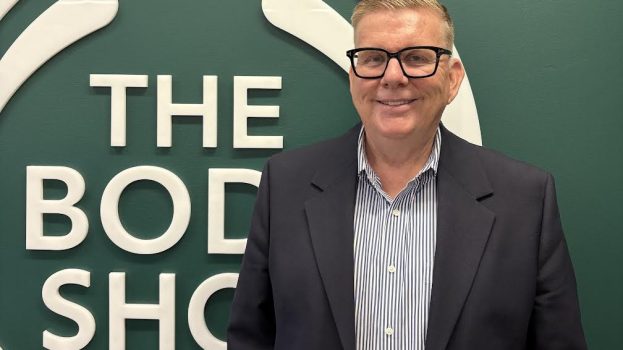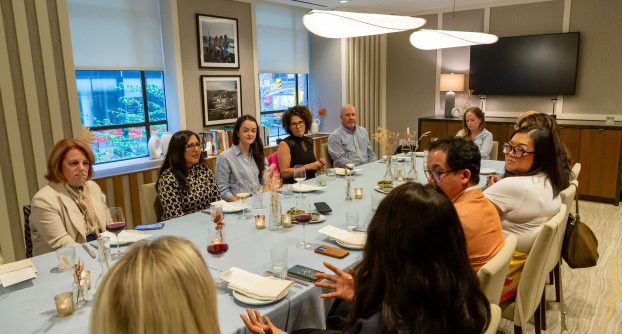Sahar Saidi launched Toronto-based LUS brands in 2017 with the goal of serving curly-haired women products designed specifically for their hair type.
Since then, the startup (whose name stands for “Love Ur Self”) has experienced explosive growth, achieving $70 million in cumulative sales through more than two million products sold to 500,000 customers globally. That achievement recently landed LUS on Canadian Business‘ list of Canada’s Top New Growth Companies for 2020.
And Saidi, who serves as CEO, has herself entered the spotlight. Last week, she was named a recipient of Canada’s Top 40 Under 40, in addition to being a 2020 RBC Canadian Women Entrepreneur Awards Start-Up Finalist.
Saidi, who bootstrapped the company with less than $100,000 in capital, has built a company rooted in encouraging women to love their curly hair – a contrast, she says, to the message often conveyed by the beauty industry. Too often, Saidi says, big beauty players frame their products as the solution to a style of hair that requires “fixing” or that is that otherwise “ugly, frizzy or unprofessional.”
Instead, she’s dubbed LUS a “non-beauty beauty brand” and has successfully grown the company through a “raw” and “unscripted” approach to advertising.
LUS has grown by more than 2,000% over the last two years. How have you achieved that level of growth?
We’re a 100% DTC brand, selling direct-to-consumer via our own website. We haven’t diversified channels yet. Going into year five, we’re starting to look at different sales channels, but staying digital and staying direct-to-consumer as much as possible.
Our marketing strategy from the beginning has been reaching customers who are online, shopping social media. Very early on, I found a self-taught Facebook marketer; she was freelancing on UpWork. She started out with a monthly budget of $1,000 a month, which I micromanaged, and she’s now our director of sales and marketing. She’s been with the company for three years, and she is building an in-house sales and marketing function.
The content [for us] was really, really important. It was all user-generated; all of our ads featured either our real employees or our real customers. We’ve never engaged in influencer marketing. I have nothing against influencer marketing – it’s a great strategy that works for a lot of brands – but I personally didn’t want to pay people to post pictures of my product or make videos using my products unless they 100% believed in them.
What started happening quite organically early on is that customers would buy the product and unsolicited, unpaid, they would create great content and send it to us. They were making their own how-to videos and sending us great photos.
So instead of partnering with influencers, we were partnering with regular customers and using our ad platforms to turn these people into micro influencers. Because we were putting ad spend behind their creative, we were tagging their handles, and they were getting new followers. And we always had this constant flow of fresh creative that was honest and genuine and that really resonated with our customer base.
Will you consider influencer marketing a channel as you continue to grow?
It’s something that we actually started to put together in the last couple of weeks. We said, ‘Okay, if we were to engage in influencer marketing, what is our strategy?’ There’s a way to do this right, and we’re trying to figure out what right means for us.
Up until now, everything has been [focused on] acquisition through social media. There have been times where we’ve partnered with external agencies. But we’ve always brought it back in house. We feel our internal team understands how to do this better than agencies, because a big part of digital advertising comes down to content and creative and copywriting. And that’s something that I still personally work on with our director of sales and marketing [Bren Harper]. Her and I have always owned this. It’s so personal to our brands and the copy you write on the creative has to resonate with your customers.
A lot of beauty brands are striving to be authentic in their messaging these days. In what way is your approach different from theirs?
We never tried – it’s something that happened organically. When I first started the company, I hired a brand strategist and I told her, ‘Look, I don’t want anyone to know my name or see my face. I just want to be the CEO and focus on the business side of things.’ But then [Bren Harper, our director of sales and marketing] showed me the numbers. She said, ‘Here’s all the creative featuring you. And here’s all of the polished, perfect creative that we spent time and money creating. Your raw videos just do so well.’
What worked for us was the fact that we didn’t have money to go out and hire agencies to create beautiful commercials. It started out with me holding up my iPhone, and just talking into the phone and being real with people and telling them what goes on behind the scenes and involving them in the product development stage early on. And some of our early customers that came in that first year are now our most loyal and that’s because they were involved.
Despite lower-than-normal growth this year, LUS is targeting 100% growth in 2021. Where’s that growth going to come from?
We’re expanding geographically. We’re about to set up [third-party logistics] in the Netherlands, so we’re targeting the EU market. Right now, we ship globally, but shipping to Australia, for example, takes 30 days and might cost the same in product costs as shipping costs to get a product to customers. By dispersing our inventory from a single distribution centre to a multi-distribution model, starting next year we’re going to be able to cut down on shipping costs and get products in the hands of more women around the world faster.
We also have new products launching. The first line that we’re launching in January is a fragrance-free version of the current core SKU. The majority of our customers love the scent of our products, but in haircare and skincare, there’s growing demand for products that are free of all fragrances… We also have a hair dryer and diffuser coming out and we’re working on body wash and body lotion. Again, that just comes from consumer demand.
So there’s tons of room left for growth right here in North America. But we pushed a lot of the plans that we had this year to next year in order to grow a little bit slower. We’re still going to grow over 40% this year, which is aggressive for most companies.
And is there any interest in going outside of DTC?
The channel that has come about quite organically is a direct-to-salon and a direct-to-stylist model. That’s because customers are buying our products and taking them into hair salons and saying, ‘Just use these products on my hair today.’ And then the stylists who, for the most part have never heard of our brand, will write to us and say, ‘I love your product. I want to carry it in my salon via the wholesale model.’
So we’ve hired a dedicated wholesale channel manager and we want to do this in an innovative way where you cut out the broker and distributor and go direct-to-salon and stylist. We’re piggybacking on the operations and the model that we built with the DTC channel and building out what we’re calling a DTS channel.
We’ve got a separate ecommerce store, a B2B platform, so salons can come on our site, add products to cart, give them different discounts depending on the volume they’re ordering, checkout and orders will be fulfilled by the same fulfillment centre as our DTC orders.
I like doing things that the majority of companies and brands aren’t doing. And this is definitely a different model.
This year, brands have had to navigate a pandemic and calls for racial justice through the Black Lives Matter movement. How did LUS respond to these events?
As far as how this pandemic affected our numbers on the marketing side, early on in March and April, [a lot of] advertisers left the space, CPMs dropped. We could have pushed and in hindsight – from a pure business lens – maybe that was the right time to push. But it didn’t feel right. So we took a very conservative approach and scaled back our ads at a time when the numbers were indicating that we should actually scale up. [We wanted] to be sensitive to what was going on in the space.
That was followed right after with the riots and Black Lives Matters movement that continue to this day. And that hit particularly hard, emotionally, because not only are we catering to a very diverse consumer base, but we have a diverse employee base. We have nine wonderful women in our customer service function – and they’re all women of colour. So we shut all of the ads off and scaled back on anything that was overly happy and overly giddy at a time that we knew our customers were struggling and suffering and our employees as well.
We wanted to be supportive as an employer and as a brand. We just said, ‘Look, there’s a lot of noise in the space right now. There are a lot of activists who’ve been fighting this fight for a long time. This is not the time for companies to shine.’
This interview is part of a series for Strategy C-Suite, a weekly briefing on how Canada’s brand leaders are responding to market challenges and acting on new opportunities. Sign-up here to receive the latest stories.
The interview has been edited for length and clarity.
























